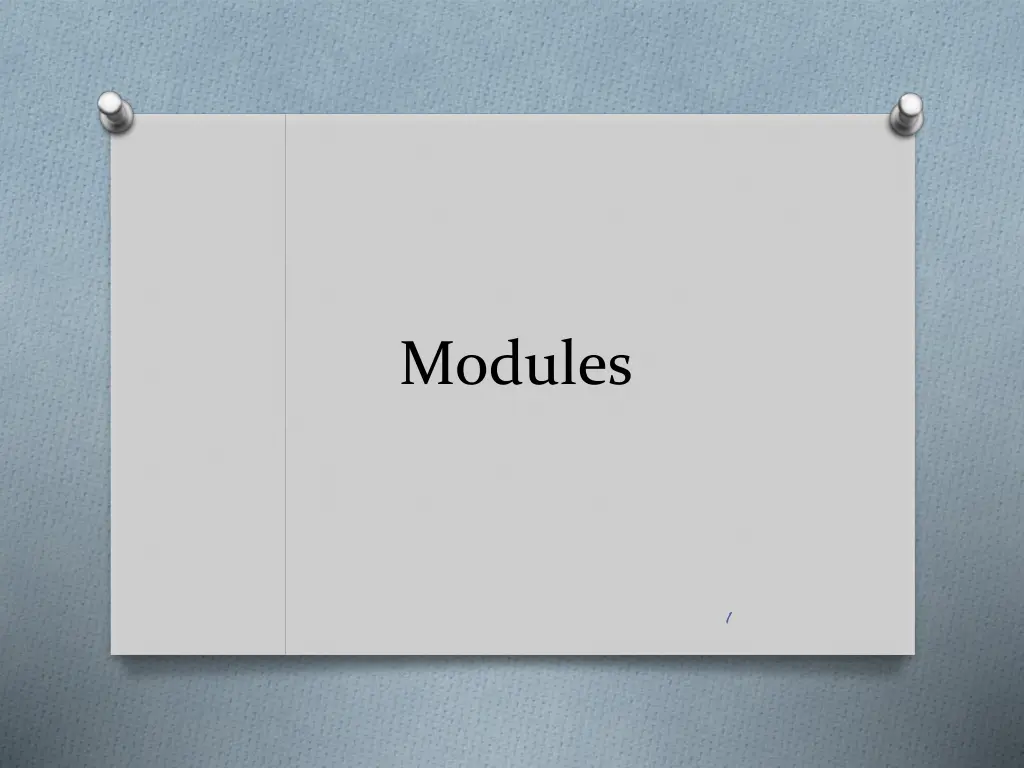
Python Modules: A Comprehensive Guide to Creating and Using Modules
"Learn all about Python modules, including how to design, import, and use them effectively in your programs. Discover the benefits of organizing code into modules for better maintenance and reusability."
Uploaded on | 0 Views
Download Presentation

Please find below an Image/Link to download the presentation.
The content on the website is provided AS IS for your information and personal use only. It may not be sold, licensed, or shared on other websites without obtaining consent from the author. If you encounter any issues during the download, it is possible that the publisher has removed the file from their server.
You are allowed to download the files provided on this website for personal or commercial use, subject to the condition that they are used lawfully. All files are the property of their respective owners.
The content on the website is provided AS IS for your information and personal use only. It may not be sold, licensed, or shared on other websites without obtaining consent from the author.
E N D
Presentation Transcript
Modules 1
Objectives O This chapter introduces 1. Introduction to a module Design and import modules Removal of ambiguity 2. 3. 2
Modules O As your program gets longer, you may want to split it into several files for easier maintenance O You may also want to use a handy function that you ve written in several programs without copying its definition into each program O Python has a way to put definitions in a file and use them in a script or in an interactive instance of the interpreter. O Such a file is called a module 3
Modules O A module is a file containing Python definitions and statements O Definitions from be imported imported into other modules or into the main main module O The file name is the module name with the suffix .py appended O Within a module, the module s name (as a string) is available as the value of the global variable __name__ a module can 4
Example # fibo.py # Fibonacci numbers module def fib(n): # write Fibonacci series up to n a, b = 0, 1 while a < n: print(a, end=' ') a, b = b, a+b print() # main.py import fibo fibo.fib(500) print(fibo.fib2(500)) def fib2(n): # return Fibonacci series up to n result = [] a, b = 0, 1 while a < n: result.append(a) a, b = b, a+b return result 5
Modules O A module can contain executable statements as well as function definitions O These statements are intended to initialize the module O They are executed only the first module name is encountered in an import statement first time the 6
Import Statement O There is a variant of the import statement that imports names from a module directly into the importing module s namespace # main.py from fibo import fib, fib2 fib(500) print(fib2(500)) O There is even a variant to import all names that a module defines # main.py from fibo import * fib(500) print(fib2(500)) 7
Import Statement O If the module name is followed by as, then the name following as is bound directly to the imported module # main.py import fibo as fib fib.fib(500) print(fib.fib2(500)) O It can also be used when utilizing from with similar effects # main.py from fibo import fib as fibonacci fibonacci(500) 8
Python Package Index O The Python Package Index (PyPI) is a repository of software for the Python programming language O You can find, install, and publish Python packages with the Python Package Index O Website: https://pypi.python.org/pypi 9
Packages O Packages are a way of structuring Python s module namespace by using dotted module names O The module name A.B designates a submodule named B in a package named A O Suppose you want to design a collection of modules (a package ) for mathematical data, you can create your package expressed in terms of a hierarchical filesystem 10
Example of a Package O To create a package named mathlib with modules fibo and matrix O Create a folder named mathlib O Add fibo.py and matrix.py in the mathlib folder O Create an empty file named __init__.py O The __init__.py files are required to make Python treat directories containing the file as packages 11
How to Call a Function of Modules defined in a Package # main.py from mathlib import fibo, matrix fibo.fib(500) print(fibo.fib2(500)) # main.py from mathlib.fibo import * fib(500) print(fib2(500)) 12
Import Two Modules with Same Function Name O When you import all functions from two modules that have the same function names, the latest one will be considered by the interpreter #mod_1.py def discount_price(p): return p * 0.8 #mod_2.py def discount_price(p1, p2): return (p1 + p2) * 0.75 #main.py from mod_1 import * from mod_2 import * print(discount_price(100)) 13
Removal of Ambiguity O Import two modules that have different names and call your preferred function via the module name to avoid ambiguity #mod_1.py def discount_price(p): return p * 0.8 #mod_2.py def discount_price(p1, p2): return (p1 + p2) * 0.75 #main.py import mod_1 import mod_2 print(mod_1.discount_price(100)) print(mod_2.discount_price(100, 200)) 14
Removal of Ambiguity O Import two modules by using as two different module names as to indicate #mod_1.py def discount_price(p): return p * 0.8 #mod_2.py def discount_price(p1, p2): return (p1 + p2) * 0.75 #main.py import mod_1 as m1 import mod_2 as m2 print(m1.discount_price(100)) print(m2.discount_price((100, 200))) 15
Exercise 1 O Design a module that contains two functions gcd(L) and lcm(L), where L is a list with numbers, and gcd(L) and lcm(L) can be used to get the greatest common divisor and the least common multiple, respectively, of the given numbers in L O Please input a list of numbers from each line of the file input.txt and use the defined functions to output the corresponding gcd and lcm on your screen Input.txt Output 100 30 40 34 52 12 9 30 24 5 10 20 40 50 16
Source O References: O https://pypi.python.org/pypi O https://docs.python.org/3/tutorial/modules. html O https://datascienceplus.com/how-to-import- two-modules-with-same-function-name-in- python/ 17






















